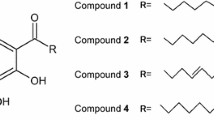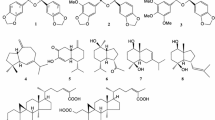Abstract
Schisandra chinensis has been used as traditional medicine. The structures of isolate active compounds (schisandrin B, deoxyschisandrin, schisandrin C) from S. chinensis were characterized by physical and spectroscopic analyses. Active compounds were tested for their potential to act as anti-melanogenesis or skin-whitening agents by their abilities to inhibit tyrosinase activity in the cell-free mushroom tyrosinase assay and cellular tyrosinase derived from B16 melanoma cells. The tyrosinase inhibitory activity was correlated to the inhibition of melanin productions in a-MSH-stimulated and unstimulated B16 cells. Cellular tyrosinase kinetics were analyzed and showed by Lineweaver- Burk plot. Schisandrin B was minimally cytotoxic (cell viability: 88.99% at 0.75 µM) and the IC50 value for suppression of mushroom tyrosinase activity was estimated as 0.6 µM. Zymography analysis demonstrated schisandrin B’s concentration-dependent effects and the kinetic analysis indicated schisandrin B’s noncompetitive-inhibitory action.
Similar content being viewed by others
References
Ip, S. P., C. T. Chen, Y. C. Kong, and K. M. Ko (2001) Effects of schisandrin B pretreatment on tumor necrosis factor-α induced apoptosis and Hsp70 expression in mouse liver. Cell Stress Chaperones. 6: 44–46.
Chen, Q. X., K. K. Song, Q. Wang, and H. Huang (2003) Inhibitory effects on mushroom tyrosinase by some alkylbenzaldehydes. J. Enz. Inhib. Med. Chem. 18: 491–496.
Chiu, P. Y. and K. M. Ko (2003) Time-dependent enhancement in mitochondrial glutathione status and ATP generation capacity by schisandrin B treatment decreases the susceptibility of rat hearts to ischemia-reperfusion injury. Biofactors. 19: 43–51.
Chiu, P. Y. and K. M. Ko (2004) Schisandrin B protects myocardial ischemia-reperfusion injury partly by inducing Hsp25 and Hsp70 expression in rats. Mol. Cell. Biochem. 266: 139–144.
Giridharan, V. V., R. A. Thandavarayan, H. N. Bhilwade, K. M. Ko, K. Watanabe, and T. Konishi (2012) Schisandrin B, attenuates cisplatin-induced oxidative stress, genotoxicity and neurotoxicity through modulating NF-κB pathway in mice. Free Radic Res. 46: 50–60.
Hearing, V. J. (2005) Biogenesis of pigment granules: A sensitive way to regulate melanocyte function. J. Dermatol. Sci. 37: 3–14.
Tsatmali, M., J. Ancans, and A. J. Thody (2002) Melanocyte function and its control by melanocortin peptides. J. Histochem. Cytochem. 50: 125–133.
Kameyama, K., C. Sakai, S. Kuge, S. Nishiyama, Y. Tomita, S. Ito, K. Wakamatsu, and V. J. Hearing (1995) The Expression of Tyrosinase, Tyrosinase-Related Proteins 1 and 2 (TRP1 and RP2), the Silver Protein, and a melanogenic inhibitor in human melanoma cells of differing melanogenic activities. Pigment Cell Res. 8: 97–104.
Solano, F., S. Briganti, M. Picardo, and G. Ghanem (2006) Hypopigmenting agents: An updated review on biological, chemical and clinical aspects. Pigment Cell Res. 19: 550–571.
Chiu, P. Y., P. Y. Lam, C. W. Yan, and K. M. Ko (2011) Schisandrin B protects against solar irradiation-induced oxidative injury in BJ human fibroblasts. Fitoterapia. 82: 682–691.
Lam, P. Y., C. W. Yan, P. Y. Chiu, H. Y. Leung, and K. M. Ko (2011) Schisandrin B protects against solar irradiation-induced oxidative stress in rat skin tissue. Fitoterapia. 82: 393–400.
Sugimoto, K., K. Nomura, T. Nishimura, T. Kiso, K. Sugimoto, and T. Kuriki (2005) Syntheses of α-arbutin-α-glycosides and their inhibitory effects on human tyrosinase. J. Biosci. Bioeng. 99: 272–276.
Pérez, G. M. and C. F. García (2001) Dimethyl sulfide, a volatile flavor constituent, is a slow-binding inhibitor of tyrosinase. Biochem. Biophys. Res. Commun. 285: 257–261.
Ma, W., M. Wlaschek, I. Tantcheva-Poór, L. Schneider, L. Naderi, Z. Razi-Wolf, J. Schüller, and K. Scharffetter-Kochanek (2001) Chronological ageing and photoageing of the fibroblasts and the dermal connective tissue. Clin. Exp. Dermatol. 26: 592–599.
Kim, S. H., M. Joo, and S. H. Yoo (2009) Structural identification and antioxidant properties of major anthocyanin extracted from Omija (Schizandra chinensis) fruit. J. Food Sci. 74: C134–C140.
Garcia, A. and J. E. Fulton (1996) The combination of glycolic acid and hydroquinone or kojic acid for the treatment of melasma and related conditions. Dermatol. Surg. 22: 443–447.
Schmidt, M., R. Kusche, W. Kronmüller, B. von Issendorff, and H. Haberland (1997) Experimental determination of the melting point and heat capacity for a free cluster of 139 sodium atoms. Physical Rev. Lett. 79: 99–102.
Rasenack, N. and B. W. Müller (2002) Crystal habit and tableting behavior. Internat. J. Pharm. 244: 45–57.
Li, C. T., Z. F. Yan, F. H. Tian, X. X. Mao, and Y. Li (2014) Chemical fingerprinting of Tussilago farara by RP-HPLC and hierarchical clustering analysis. Asian J. Chem. 26: 4003–4006.
Tipper, E. T., P. Louvat, F. Capmas, A. Galy, and J. Gaillardet (2008) Accuracy of stable Mg and Ca isotope data obtained by MC-ICP-MS using the standard addition method. Chem. Geol. 257: 65–75.
Lee, M. H., Y. P. Lin, F. L. Hsu, G. R. Zhan, and K. Y. Yen (2006) Bioactive constituents of Spatholobus suberectus in regulating tyrosinase-related proteins and mRNA in HEMn cells. Phytochem. 67: 1262–1270.
Takahashi, H. and P. G. Parsons (1992) Rapid and reversible inhibition of tyrosinase activity by glucosidase inhibitors in human melanoma cells. J. Invest. Dermatol. 98: 481–487.
Hunt, G., C. Todd, J. E. Cresswell, and A. J. Thody (1994) Alphamelanocyte stimulating hormone and its analogue Nle4DPhe7 α-MSH affect morphology, tyrosinase activity and melanogenesis in cultured human melanocytes. J. Cell Sci. 107: 205–211.
Chan, Y., K. Kim, and S. Cheah (2011) Inhibitory effects of Sargassum polycystum on tyrosinase activity and melanin formation in B16F10 murine melanoma cells. J. Ethnopharmacol. 137: 1183–1188.
Chen, Q. X., K. K. Song, L. Qiu, X. D. Liu, H. Huang, and H. Y. Guo (2005) Inhibitory effects on mushroom tyrosinase by palkoxybenzoic acids. Food Chem. 91: 269–274.
Greco, W. R. and M. T. Hakala (1979) Evaluation of methods for estimating the dissociation constant of tight binding enzyme inhibitors. J. Biol. Chem. 254: 12104–12109.
Lineweaver, H. and D. Burk (1934) The determination of enzyme dissociation constants. J. Am. Chem. Soc. 56: 658–666.
Zhang, Q., J. Wu, Z. Hu, and D. Li (2004) Induction of HL-60 apoptosis by ethyl acetate extract of Cordyceps sinensis fungal mycelium. Life Sci. 75: 2911–2919.
He, X. G., L. Z. Lian, and L. Z. Lin (1997) Analysis of lignan constituents from Schisandra chinensis by liquid chromatography-electrospray mass spectrometry. J. Chromatogr. A. 757: 81–87.
Huang, X., F. Song, Z. Liu, and S. Liu (2007) Studies on lignan constituents from Schisandra chinensis (Turcz.) Baill. fruits using high-performance liquid chromatography/electrospray ionization multiple-stage tandem mass spectrometry. J. Mass Spectrom. 42: 1148–1161.
Yukinobu, I. and K. Hiroshi (1979) The constituents of Schizandra chinensis Baill. I. Isolation and structure determination of five new lignans, gomisin A, B, C, F and G, and the absolute structure of schizandrin. Chem. Pharm. Bull. 27: 1383–1394.
Yukinobu, I. (1982) The constituents of Schizandra chinensis Baill. XII. Isolation and structure of a new lignan, gomisin R, the absolute structure of wuweizisu C and isolation of schisantherin D. Chem. Pharm. Bull. 30: 3207–3211.
Lo, Y. H., R. D. Lin, Y. P. Lin, Y. L. Liu, and M. H. Lee (2009) Active constituents from Sophora japonica exhibiting cellular tyrosinase inhibition in human epidermal melanocytes. J. Ethnopharmacol. 124: 625–629.
Mu, F. Y., M. Jin, and R. Liu (2005) Analysis of content of the Schisandra chimensis Baill fruit, rattan and fruit handles. J. Med. Sci. Yanbian Univ. 28: 28–30.
Yin, F. Z., T. L. Lu, and L. Li (2005) Comparison of γ-schisandrin contents of Fructus schisandrae of different origins in Heilongjiang province. Acta Universitatis Traditionis Medicalis Sinensis Pharmacologiaeque Shanghai 19: 42–43.
Author information
Authors and Affiliations
Corresponding author
Rights and permissions
About this article
Cite this article
Yan, ZF., Guo, J., Tian, FH. et al. Active compounds from Schisandra chinensis exhibiting tyrosinase activity and melanin content inhibition in B16 melanoma cells. Biotechnol Bioproc E 20, 814–823 (2015). https://doi.org/10.1007/s12257-014-0867-x
Received:
Accepted:
Published:
Issue Date:
DOI: https://doi.org/10.1007/s12257-014-0867-x




